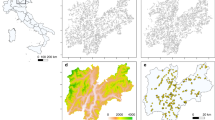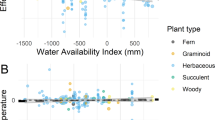Abstract
To persist, species are expected to shift their geographical ranges polewards or to higher elevations as the Earth’s climate warms1,2,3,4. However, although many species’ ranges have shifted in historical times, many others have not, or have shifted only at the high-latitude or high-elevation limits, leading to range expansions rather than contractions5,6,7,8,9,10,11. Given these idiosyncratic responses to climate warming, and their varied implications for species’ vulnerability to climate change, a critical task is to understand why some species have not shifted their ranges, particularly at the equatorial or low-elevation limits, and whether such resilience will last as warming continues. Here we show that compensatory changes in demographic rates are buffering southern populations of two North American tundra plants against the negative effects of a warming climate, slowing their northward range shifts, but that this buffering is unlikely to continue indefinitely. Southern populations of both species showed lower survival and recruitment but higher growth of individual plants, possibly owing to longer, warmer growing seasons. Because of these and other compensatory changes, the population growth rates of southern populations are not at present lower than those of northern ones. However, continued warming may yet prove detrimental, as most demographic rates that improved in moderately warmer years declined in the warmest years, with the potential to drive future population declines. Our results emphasize the need for long-term, range-wide measurement of all population processes to detect demographic compensation and to identify nonlinear responses that may lead to sudden range shifts as climatic tipping points are exceeded.
This is a preview of subscription content, access via your institution
Access options
Subscribe to this journal
Receive 51 print issues and online access
$199.00 per year
only $3.90 per issue
Buy this article
- Purchase on Springer Link
- Instant access to full article PDF
Prices may be subject to local taxes which are calculated during checkout



Similar content being viewed by others
References
Thomas, C. D. et al. Extinction risk from climate change. Nature 427, 145–148 (2004)
Thuiller, W. et al. Climate change threats to plant diversity in Europe. Proc. Natl Acad. Sci. USA 102, 8245–8250 (2005)
Colwell, R. K. et al. Global warming, elevational range shifts, and lowland biotic attrition in the wet tropics. Science 322, 258–261 (2008)
Loarie, S. R. et al. The velocity of climate change. Nature 462, 1052–1055 (2009)
Grabherr, G., Gottfried, M. & Pauli, H. Climate effects on mountain plants. Nature 369, 448 (1994)
Parmesan, C. et al. Poleward shifts in geographical ranges of butterfly species associated with regional warming. Nature 399, 579–583 (1999)
Thomas, C. D. & Lennon, J. J. Birds extend their ranges northwards. Nature 399, 213 (1999)
Parmesan, C. & Yohe, G. A globally coherent fingerprint of climate change impacts across natural systems. Nature 421, 37–42 (2003)
Moritz, C. et al. Impact of a century of climate change on small-mammal communities in Yosemite National Park, USA. Science 322, 261–264 (2008)
Lenoir, J. et al. A significant upward shift in plant species optimum elevation during the 20th century. Science 320, 1768–1771 (2008)
Tingley, M. W., Monahan, W. B., Beissinger, S. R. & Moritz, C. Birds track their Grinnellian niche through a century of climate change. Proc. Natl Acad. Sci. USA 106, 19637–19643 (2009)
Rosenzweig, C. et al. in Climate Change 2007: Impacts, Adaptation and Vulnerability (eds Parry, M. L. et al.) 79–131 (Cambridge Univ. Press, 2007)
Thomas, C. D., Franco, A. M. A. & Hill, J. K. Range retractions and extinction in the face of climate warming. Trends Ecol. Evol. 21, 415–416 (2006)
Harte, J. & Shaw, R. Shifting dominance within a montane vegetation community: results of a climate-warming experiment. Science 267, 876–880 (1995)
Arft, A. M. et al. Responses of tundra plants to experimental warming: meta-analysis of the international tundra experiment. Ecol. Monogr. 69, 491–511 (1999)
Chapin, F. S. & Shaver, G. R. Physiological and growth responses of arctic plants to a field experiment simulating climatic change. Ecology 77, 822–840 (1996)
Tuljapurkar, S. Population Dynamics in Variable Environments 91–96 (Springer, 1990)
Hampe, A. & Petit, R. J. Conserving biodiversity under climate change: the rear edge matters. Ecol. Lett. 8, 461–467 (2005)
Purves, D. W. The demography of range boundaries versus range cores in eastern US tree species. Proc. R. Soc. B 276, 1477–1484 (2009)
van Mantgem, P. J. et al. Widespread increase of tree mortality rates in the western United States. Science 323, 521–524 (2009)
Mysterud, A. et al. Nonlinear effects of large-scale climatic variability on wild and domestic herbivores. Nature 410, 1096–1099 (2001)
Deutsch, C. A. et al. Impacts of climate warming on terrestrial ectotherms across latitude. Proc. Natl Acad. Sci. USA 105, 6668–6672 (2008)
Sexton, J. P., McIntyre, P. J., Angert, A. L. & Rice, K. J. Evolution and ecology of species range limits. Annu. Rev. Ecol. Evol. Syst. 40, 415–436 (2009)
Acknowledgements
This work was supported by NSF grants DEB-9806818, DEB-0087096 and DEB-0716433. We thank the many field and laboratory assistants who have helped over the years, and J. Estes, N. Haddad, A. Rose and W. Thuiller.
Author information
Authors and Affiliations
Contributions
The two authors contributed equally to the field work, the statistical analyses and the modelling exercises reported in this paper.
Corresponding author
Ethics declarations
Competing interests
The authors declare no competing financial interests.
Supplementary information
Supplementary Information
This file contains Supplementary Figures 1-9 with legends, Supplementary Methods, additional references and Supplementary Tables 1- 4. (PDF 1439 kb)
Rights and permissions
About this article
Cite this article
Doak, D., Morris, W. Demographic compensation and tipping points in climate-induced range shifts. Nature 467, 959–962 (2010). https://doi.org/10.1038/nature09439
Received:
Accepted:
Published:
Issue Date:
DOI: https://doi.org/10.1038/nature09439
This article is cited by
-
β-1,3-glucan improved the health and immunity of juvenile African catfish (Clarias gariepinus) and neutralized the histological changes caused by lead and fipronil pollutants
BMC Veterinary Research (2023)
-
Site-specific temporal variation of population dynamics in subalpine endemic plant species
Scientific Reports (2022)
-
The expanding value of long-term studies of individuals in the wild
Nature Ecology & Evolution (2022)
-
Changes in plant composition and diversity in an alpine heath and meadow after 18 years of experimental warming
Alpine Botany (2022)
-
Contrasting climate influences on Nothofagus pumilio establishment along elevational gradients
Plant Ecology (2022)
Comments
By submitting a comment you agree to abide by our Terms and Community Guidelines. If you find something abusive or that does not comply with our terms or guidelines please flag it as inappropriate.



